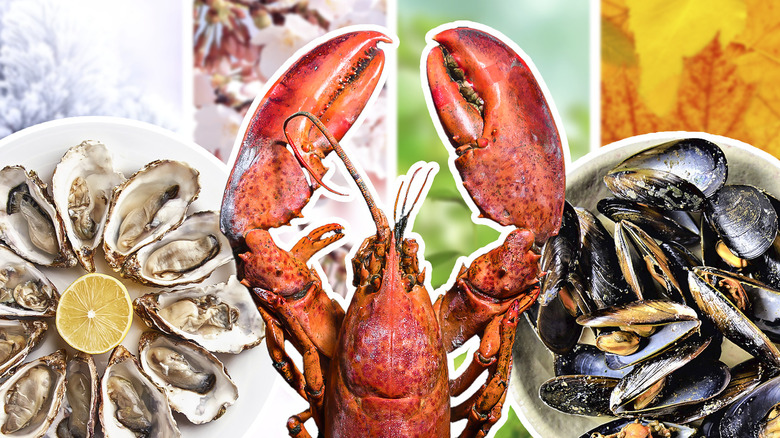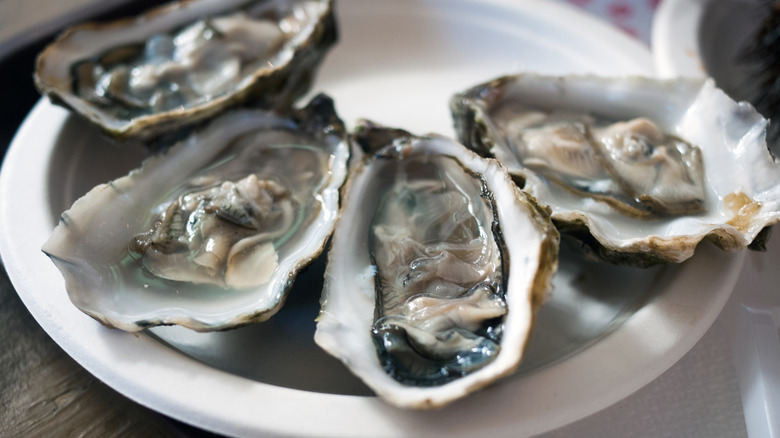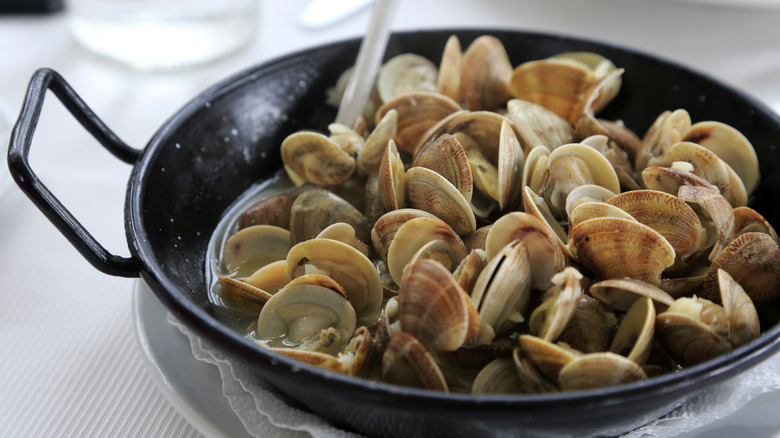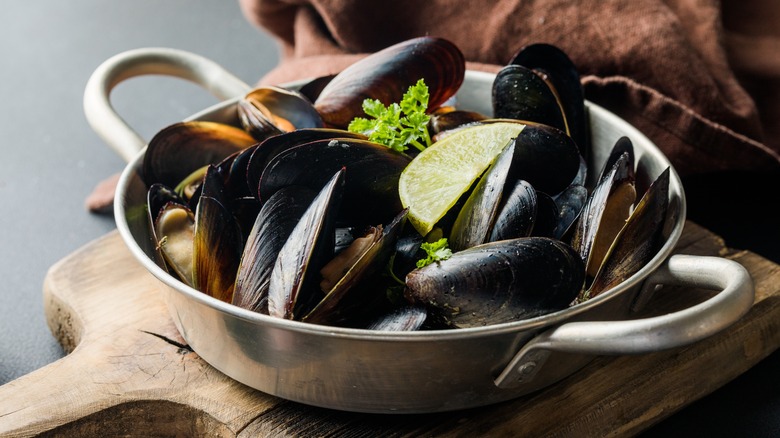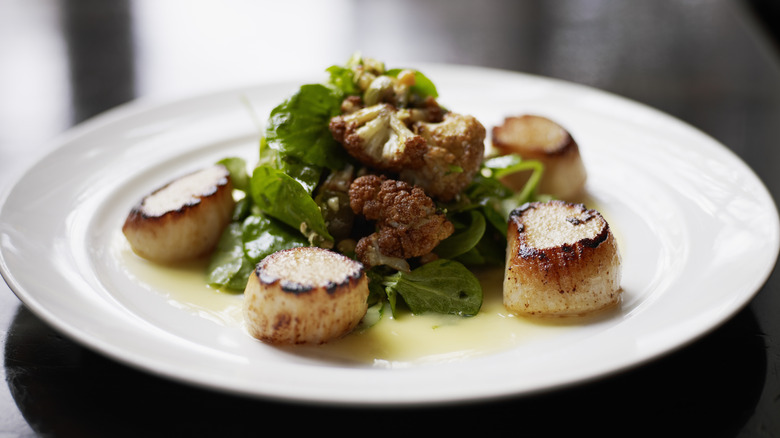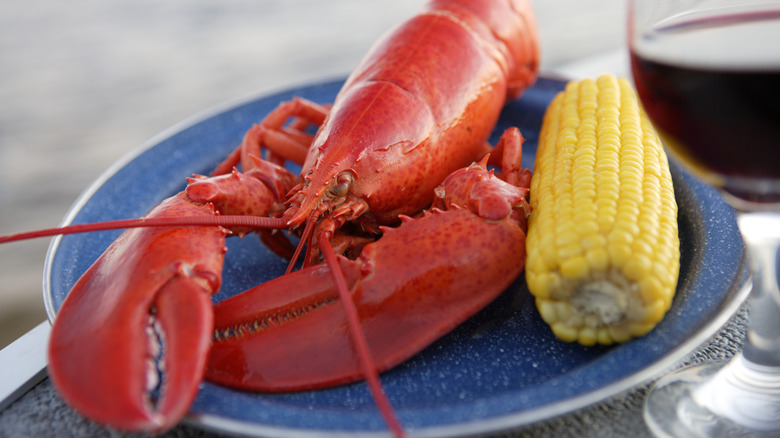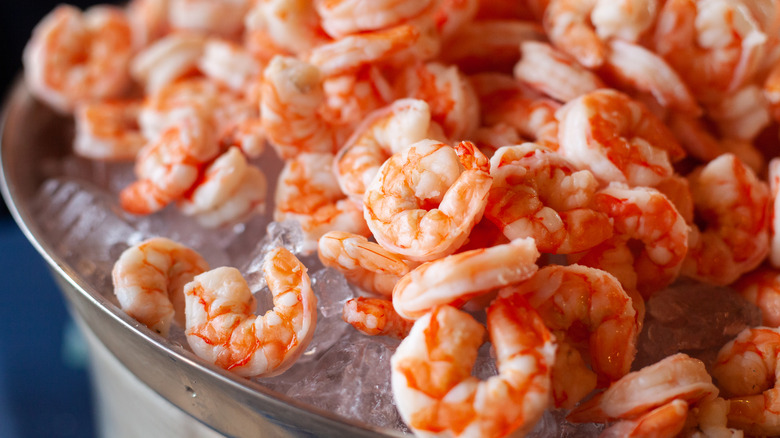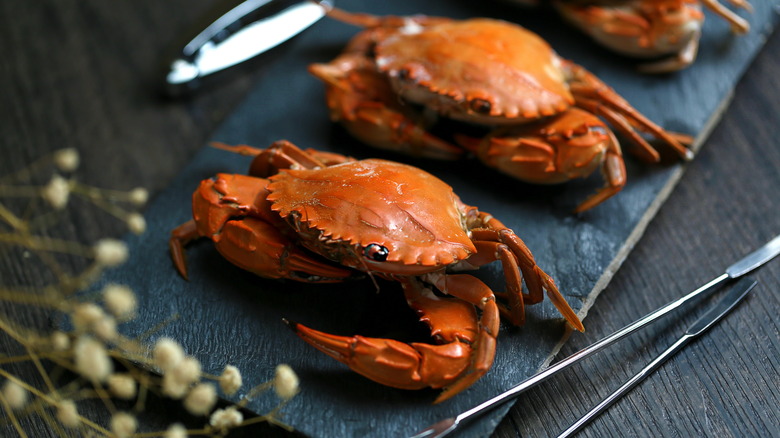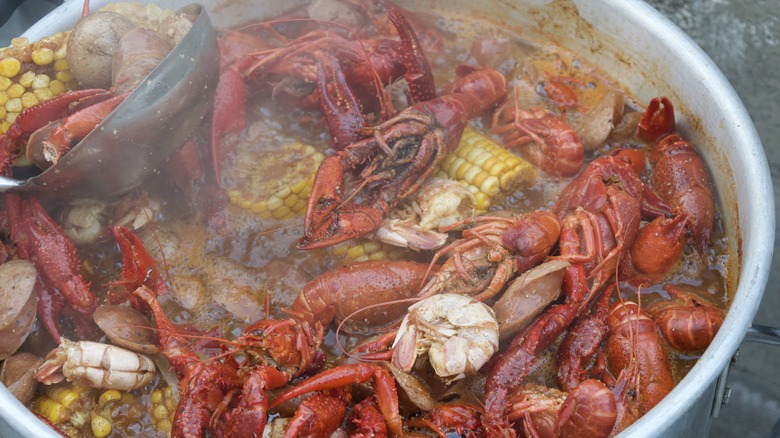The Best Season To Buy Your Favorite Shellfish
When it comes to shellfish, there's an old saying that we should only indulge in shellfish during months with an "r" in their names — September through April. This advice dates back to a time before modern refrigeration and advanced aquaculture, when the risk of spoilage and bacterial contamination made consuming shellfish in warmer months particularly risky. While this rule had its merits back in the day, Chef Sammy Monsour, author of the seafood cookbook "Salt & Shore," calls this advice outdated, as many shellfish varieties are now sustainably farm-raised and safely available fresh year-round. "It's an incredible shift that allows us to savor these delicacies whenever the craving strikes," says Monsour.
That being said, ocean shellfish still have their peak seasons, and these periods can impact more than just freshness or quality. They can alter the flavor profiles of shellfish due to factors like their reproductive cycles and changes in their diet. These seasonal variations can lead to unique taste experiences, where shellfish might taste sweeter or have different textures. Understanding these seasonal patterns can enhance your shellfish experience and help you appreciate the distinct qualities of each variety. Let's dive into the specifics of your favorite shellfish and discover when they're at their best, according to experts we spoke to Monsour, Barton Seaver, author of several cookbooks including "The Joy of Seafood" and "Two If By Sea," and Terri Dien, author of the "Essential Seafood Cookbook: Classic Recipes Made Simple" and "The Big 10 Fish & Seafood Cookbook."
Oysters
If harvested wild, oyster season generally "begins in September and ends in April," says Chef Terri Dien. However, farm-raised oysters don't have a season. They're available and fresh all year long. Chef Sammy Monsour calls oysters among "the cleanest and healthiest marine foods out there. They filter pollutants, leaving cleaner water behind." This glowing endorsement underscores just how safe (and delicious) these magnificent sea creatures are to eat.
Renowned seafood chef Barton Seaver mentions that "the physiology of an oyster site does change when the animal is focused on reproduction rather than on growth. You get a lot more glycogen — that's a fatty sugar. You get a lot more butteriness out of the oyster, so it's a little bit sweeter." Plus, you might notice a softer texture, notably different than the crunch that often accompanies New England's cold-water oysters.
Whether you're savoring wild or farm-raised oysters, or enjoying them during their reproduction cycle, Monsour points out a universal truth: "Raw oysters are more than just a treat — they're a cultural phenomenon. The experience of sitting down to a platter of fresh, briny oysters is unparalleled." So, grab a dozen, squeeze some lemon, and savor a taste of the ocean's finest any time of year.
Clams
"Today, most of the clams we enjoy are sustainably farm-raised, which means they're consistently fresh and available year-round," Chef Sammy Monsour explains. This shift to farm-raised clams has made it easier than ever to delight in these versatile shellfish anytime you like. Cultivated in controlled environments that maintain optimal conditions for their growth, farm-raised clams are not only fresh but also more environmentally sustainable compared to wild harvesting. Despite the bad rap that farm-raised seafood sometimes gets, the reality is that this practice reduces the strain on wild populations and maintains more balanced marine environments.
Wild clams, which are still a scrumptious dish we can't get enough of, are most plentiful during the cooler months, from September to April, which is the traditional shellfish season. The specific timing of harvest can vary based on location and local regulations designed to protect clam populations and ensure their sustainability. Wild clams are known for their unique flavors, which can be influenced by their natural environment, including the salinity and temperature of the water in which they grow. They also have extremely low mercury levels, which makes them a solid choice for seafood lovers.
Mussels
Wild-harvested mussels follow the same seasonal pattern as clams, peaking from September to April, according to Chef Terri Dien. During this period, wild mussels are at their best, offering rich flavors and a satisfying texture. The cooler waters of these months contribute to their robust taste. This has everything to do with their heavy summer feeding season, when they mature, attach themselves to rocks, and eat lots and lots of plankton. By fall and winter, adult mussels are well-fed and preparing to spawn — and this is the best time to harvest them. Winter mussels are sweeter and more succulent. They also have a delectable plump and creamy consistency. Dien has a special fondness for the green-lipped mussels from New Zealand, noting that they have "a soft, sweet, pale, peachy colored flesh."
Farm-raised mussels, on the other hand, are available throughout the year. These mussels are cultivated in controlled environments that support sustainable practices, resulting in a constant tasty supply of fresh, high-quality mussels. Their sweet and tender flesh is perfect for everything from simple steamed preparations with garlic and herbs to rich seafood stews, bringing a taste of the ocean to your table with every bite no matter what time of year it is.
Scallops
Scallops are a bit different from other shellfish in terms of seasonality. Terri Dien notes that they are "mostly wild-caught or harvested," with the peak seasons varying by region. In the Pacific, scallops reach their prime from July to September, when the warmer waters contribute to their sweet, delicate flavor and tender texture. Conversely, in the North Atlantic, the optimal season runs from October to March. During these colder months, scallops become firmer and more flavorful, benefiting from the nutrient-rich waters of the preceding months.
Wild-caught scallops are still what most people are eating these days, but, as Barton Seaver notes, "There's a new and very good growing industry for farm-raised scallops. It's very environmentally responsible and even beneficial in its presence in the water." Thanks to this, it's now becoming more and more possible to enjoy scallops year-round. Farm-raised scallops are grown on underwater farms where they filter plankton from the water, contributing to cleaner ocean environments. The flavor profile of farm-raised scallops is pretty comparable to their wild counterparts, offering a consistent quality that is well-suited for a wide range of culinary creations. Whether you're preparing them in a simple sear with a touch of lemon or incorporating them into a rich seafood pasta, scallops are a mild shellfish that almost anyone is bound to love.
Lobster
Lobster seasonality revolves around their molting periods, which significantly impacts their flavor. Terri Dien explains that "late spring and fall" are the prime times for harvesting "due to their growth period." This is when lobsters have hard shells filled with plenty of meat. The hard shells contribute to a firmer texture and richer flavor in the lobster meat.
During the summer months, lobsters undergo their molting process, shedding their old shells to grow new ones. This natural cycle leads to softer shells, which noticeably affects the texture and flavor of the meat. Summer lobsters are known as "new-shell" lobsters. Barton Seaver highlights the distinction between hard-shell and new-shell lobsters, explaining that new-shell lobsters have "a much sweeter flavor" but a "slightly lower yield of meat." As a lobster connoisseur and expert, Seaver calls new-shell lobster "a delicacy only available for a couple of months a year," and he very much appreciates their softer flavor.
The varying flavor profiles between hard-shell and new-shell lobsters provide a distinct opportunity for lobster enthusiasts to swoon over the diverse flavors with each season. The best part is— you don't actually have to choose which type of lobster you like better. You can simply try the differing versions depending on the season. This variation not only adds to the enjoyment of lobster but also highlights the importance of timing in seafood harvesting for shifting flavor and texture.
Shrimp
Shrimp have distinct seasons depending on where they're from. Chef Terri Dien explains that "wild-caught shrimp from the Gulf of Mexico have two seasons," providing a variety of options for shrimp lovers. Brown shrimp, known for their robust flavor and versatility, are typically available from May to June. White shrimp, prized for their sweet and tender meat, are in season from August to December. These seasonal variations make it so that consumers can eat shrimp at their freshest and most flavorful during these rotating periods. At the same time, farm-raised shrimp offer a steady supply year-round, making them convenient to enjoy regardless of the season. However, not all farm-raised shrimp are created equal. For example, Dien is not a fan of farm-raised shrimp shipped in from the South Pacific, due to concerns about warmer climates affecting their quality.
Sammy Monsour concurs with Dien's recommendation in terms of shrimp health and safety, though for slightly different reasons. He advises carefully checking shrimp labels for additives, with a particular warning about sodium tripolyphosphate (STPP). According to Monsour, this chemical is "often added to retain moisture, making the shrimp look larger, but it also imparts a bitter, soapy taste and causes them to overcook quickly." That's why he always chooses shrimp from trusted sources that value quality and sustainability. He specifically recommends Anchored Shrimp Co. in Georgia. Its shrimp "are the real deal — pure, flavorful, and free from harmful additives."
Crab
Crab seasons offer a delicious variety of flavors, with each type of crab bringing something unique to the table throughout the year. Soft-shell crab season "generally starts about March to June, depending on the area. Lake Pontchartrain is on the earlier side, Chesapeake, a little bit later. It's all about water temperature," says Barton Seaver. During this time, crabs shed their old shells and are in a molting phase, making their entire bodies, including the shell, tender and fully edible. This delicate texture is ideal for frying or grilling, where the soft shell becomes crispy, while the meat inside remains sweet and juicy. Soft-shell crabs are a seasonal delicacy that seafood lovers eagerly anticipate, and their fleeting availability makes them all the more special.
In contrast, the highly prized Dungeness crab, which Terri Dien affectionately calls "the king of crabs," hails from the Pacific and is typically harvested from November to March. Dungeness crab is celebrated for its sweet, succulent meat, which is rich and flavorful, especially when sourced fresh from coastal waters. Barton Seaver also praises its "glorious" taste, noting that the shorter season enhances its appeal, making it a must-try when it's in season. The limited availability of Dungeness crab means that seafood enthusiasts and chefs often plan their menus around its peak months, indulging in its savory, flaky meat that's excellent for everything from crab cakes to simple steamed preparations served with melted butter.
Crawfish
Crawfish, a beloved staple in Louisiana cuisine, have a peak season that goes from late February through April. During this time, the water temperatures are ideal for harvesting, and "crawfish are at their best," explains Terri Dien. The warming sea temperature creates the perfect environment for crawfish to thrive, resulting in plump, flavorful meat that's great for boiling, étouffée, and other classic dishes. For seafood lovers, this peak period is the best time to indulge in fresh, live crawfish, not only for the crawfish itself but also for the culture. Southern-born-and-raised Sammy Monsour, who has a deep appreciation for the region's seafood traditions, enjoys sourcing them during this season for festive gatherings and traditional crawfish boils, where the fresh catch can be seasoned and cooked to perfection. The excitement around crawfish season in the South is palpable, with locals and visitors alike eager to get their hands on these delicious crustaceans.
However, the end of the peak season doesn't mean you have to give up crawfish entirely. Monsour appreciates the availability of "frozen crawfish tail meat" year-round, which businesses like Louisiana Crawfish Company provide. This high-quality, sustainably sourced option allows you to enjoy the taste of crawfish whenever the craving strikes, without too much compromising on flavor and texture.
